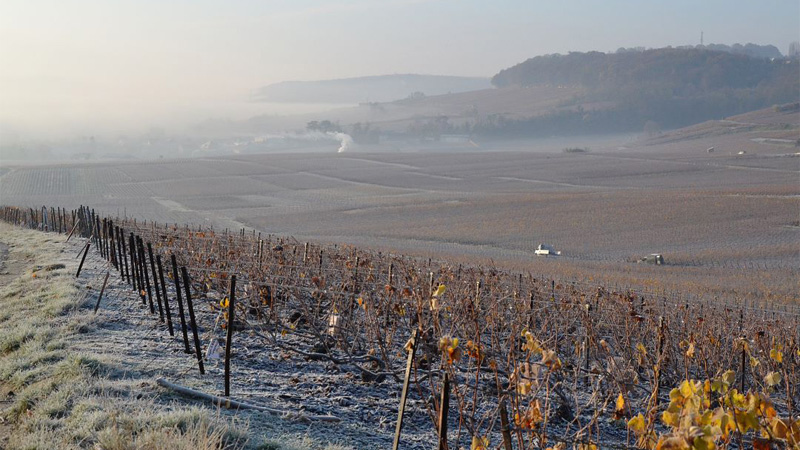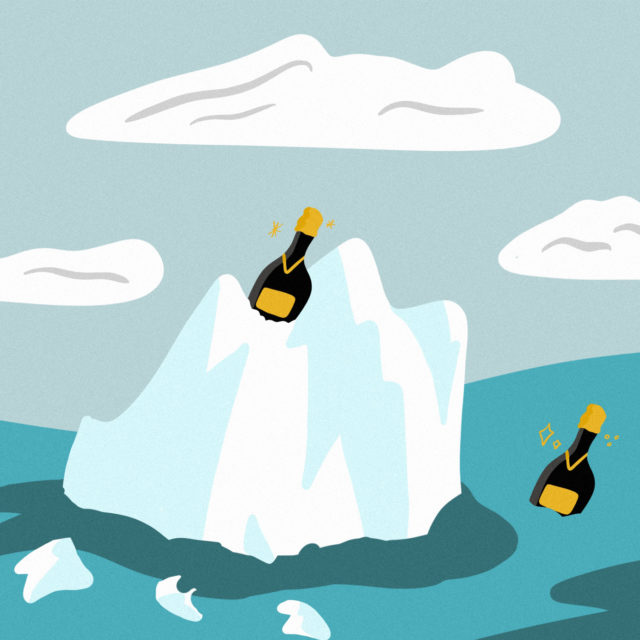Champagne, much of the world’s go-to drink for celebrations, may not be quite so dependable down the road.
In recent years, France’s Champagne producers have noted record-high temperatures and unpredictable harvests. As climate change continues to alter growing conditions, winemakers are being forced to reconsider their techniques, including vinification methods, harvest periods, and even the grapes they use. In other words, Champagne is in a constant state of flux.
“Adaptation is fully part of our daily work,” Cyril Brun, chef de caves at France’s Champagne Charles Heidsieck since 2015, says. He’s not alone: Major houses and small, independent growers alike are impacted by the rapidly changing conditions.
Don't Miss A Drop
Get the latest in beer, wine, and cocktail culture sent straight to your inbox.According to the Comité Interprofessionnel du Vin de Champagne (CIVC), the region’s trade association for winegrowers and houses, the average temperature in the Champagne region has risen 1.1 degree Celsius, or about 2 degrees Fahrenheit, over the past 30 years. This may sound small, but even a fraction of a degree of warming dramatically decreases global crop yields. This year’s growing season was no exception, reaching a record high of 42.9 degrees Celsius, or 109 degrees Fahrenheit.
Champagne’s primary grape varietals — Chardonnay, Pinot Noir, and Pinot Meunier — require very specific growing conditions. The historically wet, cool climate of northeastern France is imperative to producing the crisp, elegant flavors that are hallmarks of Champagne wines.
That’s because grapes from cooler regions don’t ripen as quickly as those from hot climates, and so they historically retain a great deal of acidity. In fact, many of the region’s signature winemaking practices, including the esteemed méthode champenoise, originated as a way to compensate for unripe grape harvests.
Now, however, winemakers are concerned their vines are maturing too quickly, producing grapes with acid levels that are too low. The Comité Champagne reports the total acidity of the region’s wines has dropped an average of 1.3 grams per liter over 30 years.
To address declining acidity levels, winemakers have leaned on blending. At Champagne AR Lenoble, reserve wine comprised an unprecedented 45 percent of this year’s non-vintage release, the Brut Intense “mag 15.” Christian Holthausen, AR Lenoble’s head of export sales and international communications, says it was necessary. “We now need reserve wines to bring freshness to our base wines each year,” he says.
AR Lenoble keeps reserves in its cellars in Damery, roughly 70,000 magnums under natural cork and under a bar and a half of atmospheric pressure. This is working for the time being, but it’s a pricey solution. “For a small, 100 percent family-owned, independent house like AR Lenoble, the investment was, and continues to be, massive,” Holthausen says.
Producers are also trying to retain their winemaking styles by blocking malolactic fermentation, a vinification process that converts fresh-tasting malic acid into softer lactic acid. The idea is that wines with detectable “malo” are often perceived to have less acidity. In 2015 and 2018, the hottest years in Champagne, AR Lenoble ended up blocking more than 90 percent of malolactic fermentation.
Charles Heidsieck’s Cyril Brun has also taken the “no malo” approach with some wines he’s worked with since 2015. Brun is experimenting with new types of yeasts to avoid oxidation, too. “I have had to gently move some cursors within my recipe to stick to my signature,” he says.
Dosage, the small amount of sugar added to most Champagnes to soften their acidity, has been reduced nearly everywhere in Champagne. It helps that zero-dosage Champagnes are having a moment, of course; but for many, the addition is simply no longer necessary.
“Sugar used to hide some unripe Champagnes. This is not the case anymore,” Michel Drappier, the seventh-generation head of Champagne Drappier in the Aube region’s Côte des Bar, says. “We produce more and more brut nature, and the quantity of liqueur added to all other cuvées has been reduced to at least half the amount.”
Florent Roques-Boizel, CEO of Champagne Boizel in Épernay, says his family has been producing a zero-dosage Champagne for the past decade for this very reason. “The trend for zero dosage will continue to develop as the climate gets warmer,” he says. “But this also means we have to be more precise and demanding to achieve perfect ripeness of our grapes with reasonable yields to achieve good concentration levels.”

For growers, the greatest challenge is arguably the rise of unpredictable harvests. Weather is erratic by nature, but recent events have made this more difficult to accommodate, even for those with decades of experience. Extreme weather patterns like frost, hail, storms, fires, and drought have more than doubled across the board since 1980, and, in Champagne, harvest has arrived an average of 18 days earlier in the past 30 years.
“Unfortunately, today we do not have any effective way to fight against frost or hail,” Jean-Jacques Cattier, chef de cave at Champagne Armand de Brignac, says. However, he adds, “reserve wines can be used to protect quality and quantity in the case of a climatic problem decreasing harvest potential.”
Sophie Larmandier, of the grower-producer Champagne Larmandier-Bernier in Vertus, estimates that 20 percent of the year’s harvest was damaged due to spring frost. It’s not a worst-case scenario — that would be 2003, when a severe frost destroyed 75 percent of the crop — but her family has learned to prepare in case nature is not feeling generous. “We don’t fight it,” she says. “We just keep several years of stock in our cellars.”
Additionally, some producers are reconsidering the four other varietals that can be used to make Champagne: Arbane, Petit Meslier, Pinot Blanc, and Pinot Gris. These grapes have mostly fallen out of use, and currently represent less than 0.3 percent of the wine grown in Champagne. Still, they present a viable option for producers looking to adapt within the strict regulations of the region.
A few growers are experimenting by replanting the varietals in trial plots or blending them into less commonly seen cuvées, like Champagne Drappier’s Quattuor, which is equal parts Chardonnay, Arbane, Pinot Blanc, and Petit Meslier. “At Drappier, we use more Arbane,” Drappier says, “as it has late ripening and with more acidity.”
Ultimately, Champagne producers may need to reckon with a groundbreaking idea, one that’s possibly unimaginable in a region so steeped in tradition: swapping out the three signature varieties — Chardonnay, Pinot Noir, and Pinot Meunier — for new grapes altogether.
The Comité Champagne is working on developing Pinot Noir, Pinot Meunier, Arbane, Gouais, and Petit-Meslier cross-breeds that are late-ripening, as well as disease- and heat-resistant. “The grape variety innovation program is specifically designed to keep the freshness of Champagne and to produce sparkling wine of excellence,” Thibaut Le Mailloux, the CIVC’s director of communications, says.
Michel Drappier is certain he and his fellow winemakers can preserve Champagne’s character and esteem in the decades to come. “We have enough tools in our hands to be confident, and our imagination to adapt our vines to a new climate will do the rest.”
Besides, he adds, “Drinking Champagne gives inspiration, doesn’t it?”
This story is a part of VP Pro, our free content platform and newsletter for the drinks industry, covering wine, beer, and liquor — and beyond. Sign up for VP Pro now!
